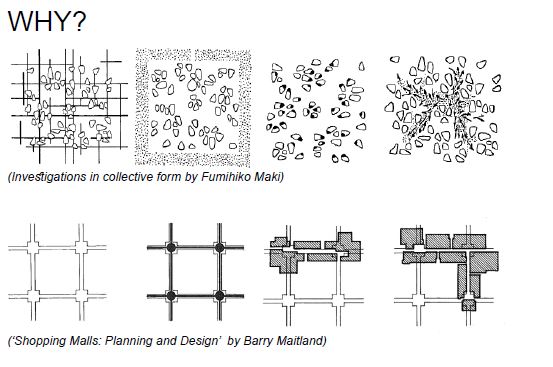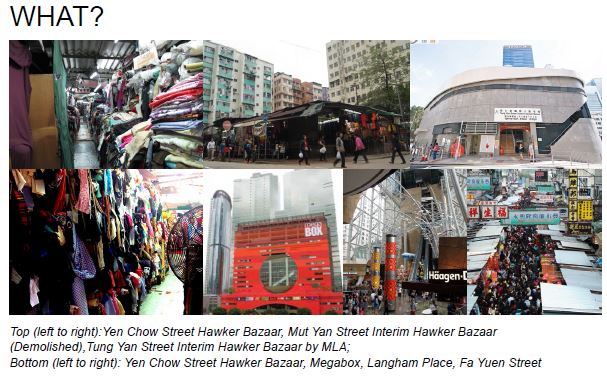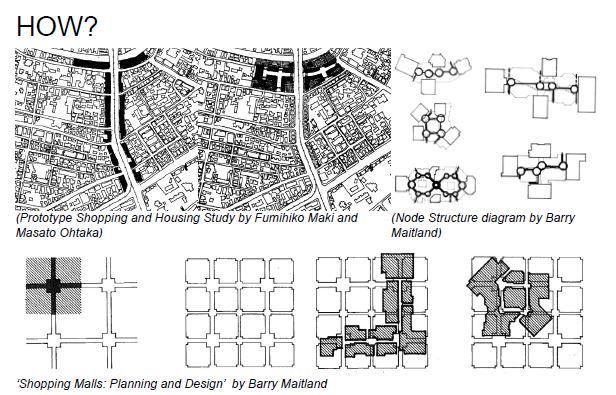|


Wall-bound Retail Space
In the past, emperors attempted to shape and define people’s lives through the regulation of lived space through city infrastructure like wall system. However, it is found out that commerce were in fact more influenced by urban trends i.e. commercial activities were more attracted to the commuter paths. Shops and business could flourish beyond the city wall. The situation is similar to our retail space nowadays which is confined to walls built and controlled by developers who are exploiting our autonomy of consumption and turning the role of consumers passive.
Flexibility and Individuality
Fumihiko Maki’s “Investigations in collective form” and “Towards Group Form” suggested the concept of organizing an orderly society without sacrificing individuality. The city is perceived as a collective form which is an agglomeration of various decisions. The focus was put in exploring a more flexible, expandable and dynamic approach in urban design.
Mall and the Street
Architecture in the past existed more as individual objects connected by network in a city which created network-induced sprawl, but as the city evolves, this kind of relationship has transformed into a more fragmented form. Relatioship between people and architecture has become more point-to-point and dispersed. From Barry Mairland’s shopping mall study, it could be seen that many early modern shopping mall layout in fact intended to bring upon the idea of “street of shops’ as remembrance. After years of modern development and being refined to fulfil financial and economic needs, modern retail layouts are mostly generated from desired formula. The shopping mall is now seen as a urban transplant being reintegrated into the original street fabric. The question arises would be whether it would incur disruption, rejection or on the contrary, generate new city patterns.
With regard to the question of what is a good mix of retail space to the city. The thesis is to challenge how the new shopping mall typology could be reintegrated into the original street fabric and rethink the possibility to reintegrate the mixed character of street space in order to reactivate the gradually fading urban streetscape in Hong Kong.

Urban development in Hong Kong
As the urban renewal projects in Hong Kong start to redevelop old districts, hawker bazaars that have been deeply attached to old urban fabric are being uprooted one by one. Mut Wah Street Interim Hawker Bazaar was one of the examples that all the hawker stalls have been relocated to the new Tong Yan Street hawker bazaar building provided by the government.
Retail development in relation to urban evolution
As the city evolves, the modern shopping mall typology is dominating the market as they suit the market need for both developers and users. However, the way of complete erasure of the old street market typology is remained controversial over the city. This thesis would like to propose a new urban typology that can accommodate street space with mixed characters. The study will start with analyzing different typologies of retail space in Hong Kong. From the massive type of modern shopping malls like Megabox to interim hawker bazaar to the street market type, various factors and parameters of them whether successful or not would be studied and mapped out, in order to extract the essential quality to attract and induce flow of people and thus activating the streetscape.
Potential test case
Yen Chow Street Hawker Bazaar has been a landmark fabric wholesale market with unique character in Sham Shui Po but it will be closed down soon as the site will soon be redeveloped. The government has been experimenting the possibility to relocate the stalls within the district. To the shop owners, they do not belong to vertical building. They belong to the streetscape and exist in cluster and group naturally. Sham Shui Po is also a unique old urban district in Hong Kong that will soon be redeveloped. Therefore, the new typology proposed will be experimented on this site for a mixed development reintegrating the original streetscape and vibrance of the old bazaar.

1. To differentiate and study typologies of existing retail spatial layout in Hong Kong.
2. To study the pedestrian movement and flow of people in relation with the organization of retail space by analyzing with node structure diagrams of retail space and city patterns.
3. To propose a typology which can act as activator and recapture the vibrance urban streetscape by using the hawker bazaar in Sham Shui Po as a test case.
BIBLIOGRAPHY
Theory:
1. Mumford, Lewis. “Commercial Expansion and Urban Dissolution.” In The city in history: its origins, its transformations, and its propects, by Lewis Mumford, 410-445. San Diego: Harcourt, Brace & Co., 1989.
2. OASE Journal for Architecture OASIS #26-27 046. OASE Foundation & NAi Publishers, 1989.
3. Yona Friedman: Pro Domo. Barcelone: ACTAR, 2006. Print.
4. Li, Shiqiao. Hong Kong; City of Maximum Quantities. In Asian Alterity, by William S.W.
Lim. Singapore: World Scientific, 2008.
Techniques:
1. Maitland, Barry. Shopping Malls: Planning and Design. London: Construction Press, 1985. Print.
Seminal / Current Projects:
1. Maki, Fumihiko. Investigations in Collective Form. St. Louis: School of Architecture, Washington U, 1964.
2. Karissa Rosenfield. “OMA Designs Food Port for West Louisville” 23 Feb 2015. ArchDaily.
Images:
“Langham Place Atrium View 201308” by Wing1990hk – Own work. Licensed under CC BY 3.0 via Commons – https://commons.wikimedia.org/wiki/File:Langham_Place_Atrium_View_201308.jpg#/media/File:Langham_Place_Atrium_View_201308.jpg
Mk2010 (Own work) [CC BY-SA 3.0 (http://creativecommons.org/licenses/by-sa/3.0)], via Wikimedia Commons
Wing1990hk (Own work) [CC BY 3.0 (http://creativecommons.org/licenses/by/3.0)], via Wikimedia Commons
Building Journal: Jian Zhu. Hong Kong: Trend Pub. (HK) Ltd, 2007. Print.
|



